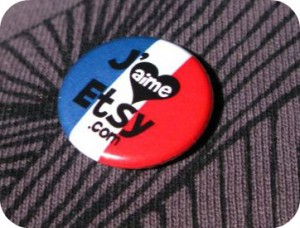 In 2005 the website Etsy launched as an online marketplace where artisans across the country could sell their wares. The Brooklyn-based company quickly established itself as a destination for handcrafted items that shoppers wouldn’t find in any stores. As the years progressed Etsy’s army of craft sellers grew into the thousands, with women accounting for a whopping 85 percent of them. The company marked a major milestone in 2012 when it became a certified benefit corporation. By 2015 Etsy’s stock had gone public on the Nasdaq exchange as executives started classifying the company as a tech firm and its sellers as “creative entrepreneurs.”
In 2005 the website Etsy launched as an online marketplace where artisans across the country could sell their wares. The Brooklyn-based company quickly established itself as a destination for handcrafted items that shoppers wouldn’t find in any stores. As the years progressed Etsy’s army of craft sellers grew into the thousands, with women accounting for a whopping 85 percent of them. The company marked a major milestone in 2012 when it became a certified benefit corporation. By 2015 Etsy’s stock had gone public on the Nasdaq exchange as executives started classifying the company as a tech firm and its sellers as “creative entrepreneurs.”
But buzzwords weren’t the only thing that Etsy’s management changed about the company in their quest to expand. When the website first launched, all the items listed had to be handcrafted by the seller or one of their employees. This created a vibrant marketplace filled with unique items that immediately attracted customers. As the years went by, however, scaling up this system proved to be a challenge. After all, Etsy’s artisans could only work as fast as their hands allowed, causing the site’s supply to stagnate just as it was looking to bring in more customers. To solve this problem, two years ago Etsy told its sellers that they now only had to show “authorship” over a product’s design and development rather than proof that they made it by hand.
This change swung the doors wide open for manufactured goods to be sold on the site. Besides proving that they designed a specific item, sellers must also disclose how the product is made and how many people are involved in making it. Although this has expanded Etsy’s supply, longtime sellers on the site fear the changes will harm the company’s reputation for selling artisanal goods. “Every mass-produced pillow in the world had to be designed by people who worked with a factory,” said one established Etsy seller. “How does Etsy’s claim of being a handmade marketplace hold any water now?” Executives don’t seem too concerned, however, and have even introduced a program that helps sellers reach out to company-approved factories. Whether or not Etsy’s customers start to rebel against these mass-produced items remains to be seen.
Questions:
- Will these changes damage Etsy’s reputation with customers? Does it undermine the company’s status as a benefit corporation?
- Why are handmade, artisanal products more appealing to some consumers than mass produced items?
Sources: Susan Berfield, “Etsy’s Handmade Label Now Includes ‘Artisanal’ Factories,” Bloomberg Businessweek, March 3, 2016. Photo by Moon Angel.
